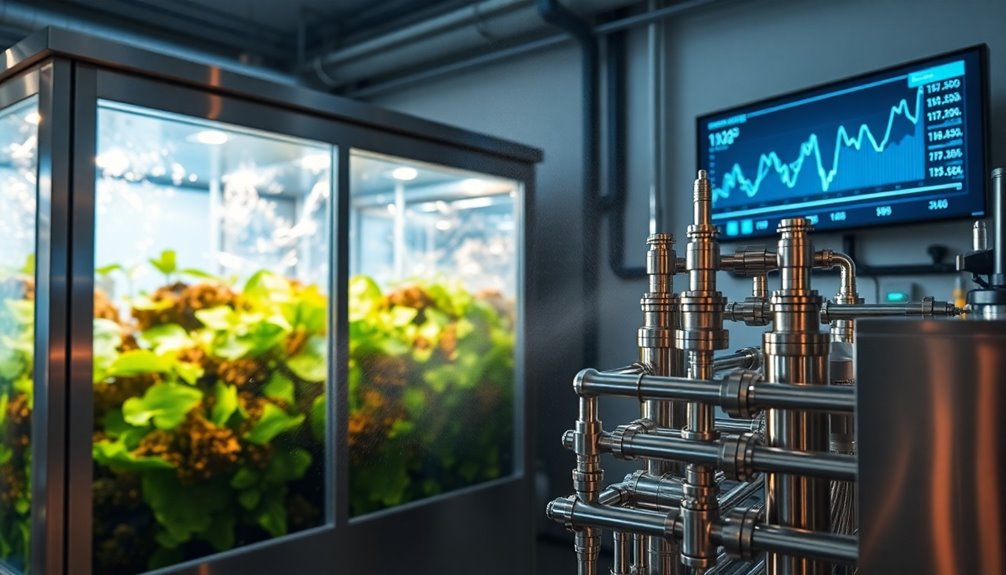Boosting biobutanol yields is possible with advanced online product separation technology. Techniques like in situ product recovery and zeolite adsorption allow for high-purity recovery, cutting energy costs significantly. Innovations such as heat pump-assisted distillation and membrane filtration enhance efficiency while reducing waste. These methods not only improve yields but also make production more sustainable and competitive against fossil fuels. Discover how these cutting-edge technologies can transform your biobutanol production process.
Key Takeaways
- Advanced separation technologies like heat pump-assisted dividing-wall columns minimize energy consumption and enhance biobutanol yield efficiency.
- In situ product recovery (ISPR) techniques, such as gas stripping, significantly increase biobutanol concentration during production.
- Zeolite adsorption allows for high-purity butanol recovery while being reusable, contributing to sustainability and cost-effectiveness.
- Membrane filtration and electrifiable membranes concentrate biobutanol with lower energy costs, improving overall production efficiency.
- Implementing energy efficiency methods like vapor recompression can reduce separation energy requirements by over 50%, boosting competitiveness with fossil fuels.

Biobutanol production is gaining traction as a sustainable alternative to fossil fuels, but achieving high yields efficiently remains a challenge. To tackle this, advanced separation technologies are crucial. Traditional distillation methods are energy-intensive and often involve multiple columns, driving up costs. However, intensified separation processes, like heat pump-assisted azeotropic dividing-wall columns, can significantly reduce energy consumption while enhancing efficiency.
Advanced separation technologies are essential for efficient biobutanol production, reducing energy costs and improving yields significantly.
In situ product recovery (ISPR) techniques, such as gas stripping, can boost butanol concentration before the separation stage, making the overall process more economical. Additionally, utilizing zeolite adsorption for high-purity butanol recovery can lower energy costs substantially. By employing pinch technology, you can integrate heating and cooling processes, optimizing energy use and minimizing waste.
Energy efficiency is the name of the game in biobutanol separation. Techniques like vapor recompression can slash energy requirements by over 50%. When you apply heat integration methods, such as pinch analysis, you'll notice a marked decrease in overall energy consumption, which is vital for making biobutanol competitive with fossil fuels. Low-carbon technologies not only promote a sustainable production model but also reduce greenhouse gas emissions, aligning with global sustainability goals. The energy requirement for butanol separation can be reduced by 58% using advanced techniques like the heat pump-assisted azeotropic dividing-wall column.
Innovative materials play a pivotal role in these advancements. For instance, zeolites can achieve effective adsorptive separation and can be reused multiple times, enhancing cost-effectiveness. Membrane filtration is another emerging technology that allows you to concentrate biobutanol without incurring high energy costs. Electrifiable membranes are also being increasingly adopted, further pushing the envelope in energy-efficient biofuel production.
With biobutanol's applications spanning the fuel and chemical industries, and its potential for blending with gasoline and producing specialty chemicals, the market demand is robust. By leveraging these advanced separation technologies, you can significantly boost biobutanol yields while supporting sustainability and economic feasibility in the biofuel sector.
Frequently Asked Questions
What Are the Environmental Benefits of Biobutanol Compared to Traditional Fuels?
When you consider biobutanol compared to traditional fuels, you'll notice significant environmental benefits.
Biobutanol reduces carbon emissions, as it's produced from biomass that captures CO2. It also utilizes organic waste, cutting down pollution from decomposition.
Additionally, its lower evaporative emissions and immiscibility with water prevent water pollution.
How Does Biobutanol Production Impact Food Supply and Prices?
Biobutanol production can significantly impact food supply and prices. If you use food-related feedstocks like maize, it competes directly with food crops, potentially driving up prices.
However, opting for non-food biomass, like organic waste, alleviates this issue and helps maintain food security. By selecting sustainable feedstocks, you can minimize negative effects on food availability while supporting economic stability and reducing food price inflation.
It's a delicate balance worth considering.
What Are the Safety Considerations in Biobutanol Production?
In biobutanol production, you need to prioritize safety considerations due to exposure to hazardous chemicals like butanol and acetone.
You'll face risks of fire and explosion, so implementing stringent safety measures is essential. Regular health assessments can help mitigate occupational hazards, while protective gear and protocols reduce exposure risks.
Additionally, designing processes with environmental impact in mind ensures compliance with regulations, safeguarding both worker health and the surrounding ecosystem.
How Does Biobutanol Perform in Different Engine Types?
Biobutanol performs differently across engine types.
In diesel engines, it reduces viscosity but might lower power output.
Gasoline engines benefit from lower knock tendency and improved emissions.
In compression-ignition engines, it enhances combustion but may require cetane improvers.
While biobutanol blends can slightly increase fuel consumption, they generally reduce NOx emissions.
Each engine type adapts uniquely, requiring modifications for optimal performance with biobutanol blends, so you'll want to consider these factors.
What Are the Economic Implications of Scaling Biobutanol Production?
Imagine a tree growing in a garden; the more you nurture it, the larger and more fruitful it becomes.
Scaling biobutanol production mirrors this growth. As you expand, you lower costs through economies of scale and improved efficiencies. You can harvest more while reducing raw material expenses, enhancing profitability.
Conclusion
By harnessing cutting-edge separation technology, you're not just boosting biobutanol yields; you're revolutionizing biofuel production! Imagine cranking out more biobutanol than you ever thought possible, turning your facility into a powerhouse of green energy! With every drop you extract, you're not just making a product; you're paving the way for a sustainable future. It's a game-changer that'll have you wondering why you didn't adopt this technology sooner. The future's bright, and it's filled with biobutanol!









